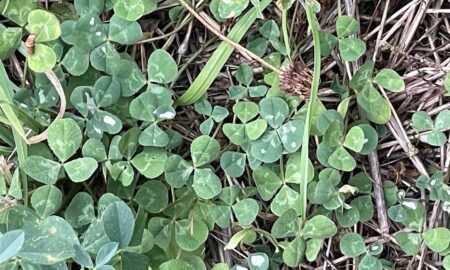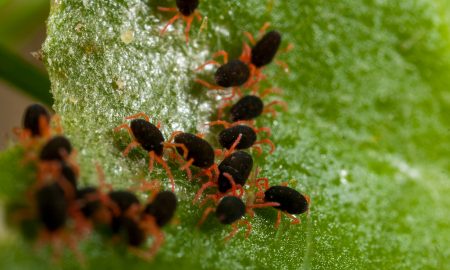Armyworms have been causing widespread foliar damage to cereals and, for possibly for the first time, lentil crops across western Victoria and southern NSW.
Where have they been reported?
It appears as if armyworm infestations are now widely distributed in the Victorian Mallee and Wimmera and parts of the NSW Riverina. Infestations have often been mixed with the herringbone patterned Noctuid caterpillar Proteuxoa species.
The armyworms appear to be inland armyworms (Persectania dyscrita), although positive identification can only be made through examining the adult moths.
Reports of two wheat crops in the Victorian Mallee (one approximately 50 km west of Ouyen and one 40 km southwest of Swan Hill) have been attacked by a combination of armyworms and the herringbone caterpillar. In both cases the tillers of plants in large patches had been chewed right off to within a few centimetres from the ground. It cannot be confirmed which species was responsible, but it was probably armyworm. The damaged patches were substantial (approximately 30-40 acres in one case) and were sprayed with alpha-cypermethrin. Both crops had high standing cereal stubble throughout the paddock, and the damage was much worse in areas with thick stubble loads.
Similarly, barley crops near Donald in the Victorian Wimmera have been attacked by mid to late stage armyworms (no herringbone caterpillars were present) that have left extensive scalloping of leaves in distinct patches through the paddocks. One particular crop needed to be sprayed due to the accumulative impact of armyworm damage plus moisture stress.
In the last week there have also been three unusual cases of armyworms damaging lentils, one near Sea Lake, one near Birchip and the other west of Swan Hill, all in the Victorian Mallee. In all cases some of the lower branches had been chewed off and strewn on the ground. One crop was inhabited by a mix of armyworm and herringbone caterpillars (the most abundant species), with feeding to plants occurring across the paddock. The other two crops seemed to be damaged entirely by armyworms. The most severe damage occurred in large patches, which is typical of armyworms.
About armyworms
Armyworm caterpillars are brown in colour, with three distinctive stripes on the thoracic segment directly behind the head and often along the entire body length to the tail (Note that cutworms tend to have no distinct markings).
The preferred plant hosts for armyworms are cereals and grass pastures. They are, however, voracious feeders, especially at the later growth stages and if their preferred food source is depleted (either by feeding or by weed control), they may move onto another, less preferred, food source. This may explain the damage apparently caused to lentils, which would not normally be within their host range.
Armyworm moths commonly lay their eggs in crevices of dried grasses, straw and stubble. Areas of thick-standing cereal stubble attract most armyworm moths; hence this is commonly the areas of a paddock where most armyworm damage is seen. This is particularly typical behaviour of inland armyworms.
As with most native migrant pests, armyworms complete only one generation at a single location: eggs are laid in the crop, larvae develop and pupate in the soil. Adult moths emerge and, in most cases, migrate further to the south and east.
For comprehensive information on this pest, including their occurrence, lifecycle, behavior and management strategies, go to armyworms within the new PestNote series.

Our advice
If signs of extensive leaf scalloping in patches within a crop are visible, monitor the crop for armyworm caterpillars, preferably after dusk. Use a sweep net if possible. Intensive feeding often occurs in patches. During the day, look for pellets of excrement (or ‘frass’) at the base of plants (for larger caterpillars, the pellets are about the size and shape of a match head).
In cereal crops, the range of armyworm feeding varies from leaf scalloping during plant growth in winter and early spring, to the severing of maturing seed heads late in spring as the plant begins to senesce.
The current generation of inland armyworm is unlikely to persist beyond September, after which time the moths depart. At this time of year, it is generally not necessary to control armyworms in cereals, even though the feeding damage can appear considerable.
The current influx of inland armyworms does not preclude the possibility of an independent generation of common armyworms (Leucania convecta) appearing in spring, so continued monitoring with a sweep net in late September is recommended.
Control of armyworms is best achieved as close as possible to dusk, as this is when the caterpillars will be on the plants. There are several insecticides registered for control of armyworms in broadacre crops, though most will also kill the beneficial invertebrates.
The trade-off between spraying for these at this point in time is that the insecticide will wipe out populations of beneficial insects residing in the crop, that, in spring will play an important role in keeping aphid and young caterpillar numbers in check.
Acknowledgements
Sources of field reports of armyworms
Brett Atkin – Agronomist, Elders (Victorian Mallee)
Matt Bissett – Agronomist, AGRIvision (Victorian Mallee)
Jason Brand – Senior Research Agronomist, Vic DEDJTR (Victorian Mallee)
Kris Dixon – Agronomist, Landmark (Victorian Wimmera)
Luke Maher – Agronomist, AGRIvision (Victorian Mallee)
James Mckee – Grower (Victorian Mallee)
Cover image: Photo by Cesar Australia





